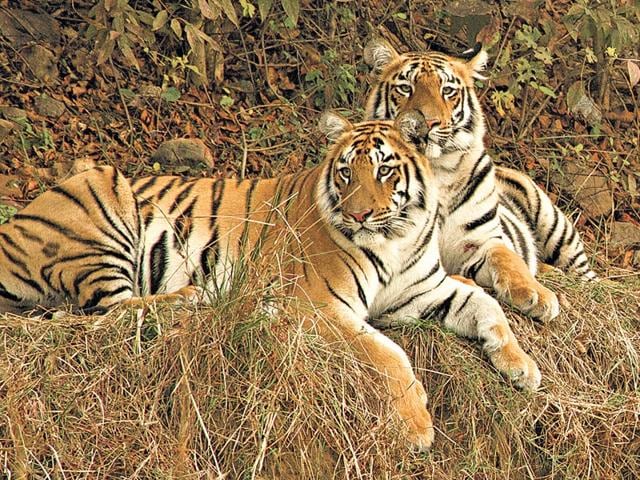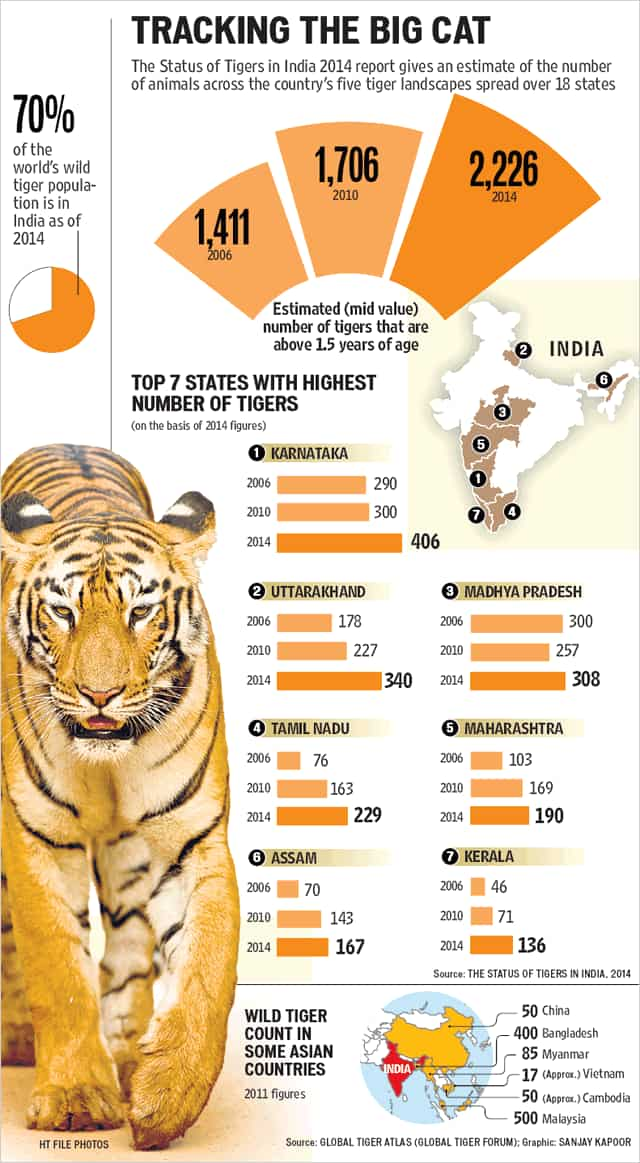The roar is back: India's tigers are on their prowl again
A recent report released by the environment and forest ministry says the big cat count in the country has gone up by 30% in four years. We decode the success story and look at the challenges ahead.
The story of Panna is representative of a bigger battle, one that was fought across forests in the country to check the dwindling number of tigers post 2006, when the nationwide estimate had revealed that India had only 1,411 wild tigers older than 1.5 years of age. Today, according to a recent report released by the ministry of environment, forests and climate change, there are 2,226 tigers. Between 2010, when the second estimate was done, and 2014, there has been a 30% increase in the number of wild tigers over 1.5 years of age. Four years ago, the number stood at 1,706. "One can’t compare the estimates prior to 2006 with the count in 2006 and since. Before 2006, the estimates were based on the total pug mark count which was not as scientific" explains Rajesh Gopal, who just retired from the post of member secretary, National Tiger Conservation Authority and ADG Project Tiger. Without indulging in the debate of whether the drop in the tiger count was abrupt or took place over a period of time, what the 2006 estimate did establish beyond doubt was that India was left with very few tigers. As conservationist and author Valmik Thapar puts it, "In 2006 poaching was causing the decline. Ranthambhore had lost half its tigers, Sariska all its tigers, and Panna was on its way to losing all its tigers." While the counting methodology continues to be contentious — conservationist and wildlife biologist Ullas Karanth says "the double sampling method to estimate numbers of tigers is invalid statistically. The results are not reliable for large areas," — 2,000 plus tigers is a good indicator, says Thapar. So how was this success story scripted? "Since 2006 successive governments have taken some milestone initiatives. While the Project Tiger scheme already existed, it lacked statutory support. In 2006, The Wild Life (Protection) Act, 1972 was amended to enable provisions for constituting the National Tiger Conservation Authority (NTCA) and the Tiger and other endangered species Crime Control Bureau. Punishment for offences related to hunting in tiger reserves or altering the boundaries of tiger reserves was enhanced."


Laws on paper were, however, hardly enough to check the decline. "There were three main threats that the tigers were facing — habitat destruction and encroachment, poaching of tigers and animals that serve as prey for the tigers, and human-tiger conflict. Patrolling and protection was poor and there was a lack of good crime detection and intelligence-led enforcement," explains conservationist Belinda Wright. A new set of guidelines was issued to state governments. This included financial support to states for enhanced voluntary village relocation or rehabilitation packages for people living in core or critical tiger habitats (varying from Rs 1 lakh per family to Rs 10 lakh per family) and the rehabilitation or resettlement of communities involved in traditional hunting. Elsewhere, the local people, those living in villages around the core forest area, were involved in the conservation process. "For instance, they were inducted into the local taskforce for patrolling against poaching. The Special Tiger Protection Force (STPF) was set up," says Gopal. Non-governmental authorities contributed immensely in the conservation efforts. "Dr Ullas Karanth influenced the science of counting and his NGO in Karnataka works both with conservation and monitoring of wild tigers across southern states. Other NGOs contributed to antipoaching efforts," says Thapar. The threat from poachers, though, is hardly a thing of the past. Says Shekhar Niraj of TRAFFIC, "We continue to lose approximately 20 to 25 tigers to poaching every year." While there are no estimates of the worth of the illegal trade in tiger parts, that big money is involved is a given. "China is the biggest market for tiger parts — skin, claws and bones," says Wright. The country’s tiger farms are notorious for breeding animals in captivity to satisfy commercial demands. India is the founder member of the Global Tiger Forum of Tiger Range Countries for addressing international issues related to tiger conservation. As of 2014, "India has 70% of the world’s tiger population," says Gopal. During a conference in Hague in 2007, India introduced a resolution along with China, Nepal and the Russian Federation, with direction to parties with operations breeding tigers on a commercial scale, for restricting such captive population to a level supportive only to conserving wild tigers. India has also appealed to China to phase out tiger farming. There have been bilateral understandings with Nepal and Bangladesh. A sub-group on tiger and leopard conservation has been constituted with the Russian Federation.

There is, however, little time for complacency. "The present estimation reveals that, in Buxa Tiger Reserve, in West Bengal, there is no presence of any tigers and only a suspicion of two or three," says Thapar. "We need to have more coverage of the area under strict protection and we need to enable the wider participation of researchers and NGOs in tiger conservation. We have enough forest still to support 5,000 or more tigers," says Karanth. In a book titled Dynamic of Tiger Management In Priority Landscapes, Gopal writes of the importance of corridors to facilitate the movement of the animals across different tiger landcapes. Such movement also ensures good gene flow. Says Wright, "One does not need to make these corridors protected areas. People can live here or use them as agricultural land. The movement of tigers is restricted only when one makes highways or railway tracks on these corridors, or deep canals, mines or factories."
As Gopal writes in his book, "There is a great demand from various sectors for using forest land." This is unavoidable in a developing economy like India’s. The trick is to find that oft-quoted balance. While the conservaiton of forests and wildlife shouldn’t mean turning one’s back on construction and industrialisation, the government needs to approach such projects with caution to ensure that the economic benefits do not damage the country’s ecological balance.
How Periyar Saved Its Big Cat Population
By Kumkum Dasgupta
kumkum.dasgupta@hindustantimes.com
The Periyar Tiger Reserve (PTR) in Kerala is one of most-feted tiger reserves in India. One of the main reasons for this is PTR’s people-oriented and park-centered conservation and ecotourism programmes that the forest department runs with the help of eco-development committees (EDCs). Earlier this month, the 925-sq km reserve, home to about 40 tigers, bagged the National Tiger Conservation Authority’s (NTCA) award for encouraging local public participation in its management. In 2012, PTR, situated in the Cardamom Hills and Pandalam Hills of the southern Western Ghats, won the UN-India Biodiversity Governance award for holistic management strategies. “The work with the EDCs — local communities are its members — started almost 10 years ago. We keep adding and deleting programmes depending on results,” says Sanjayan Kumar, deputy director of PTR. The reserve has also been identified by the Ministry of Environment and Forests as a ‘Field Learning Centre’. “This recognition came as a result of the PTR being designated a centre of excellence for successfully implementing the India Eco-Development Project (IEDP),” added Kumar. The goal of IEDP was the conservation of bio-diversity through people’s participation.
In India, protected areas (PA) can never be ‘exclusive’ because people live in and around them. This population is rural, poor and dependent on the resources of the PA. Ecodevelopment programmes, like the ones in the Periyar Tiger Reserve, aim at conserving the bio-diversity by addressing both the impact of local people on the PAs and the impact of the PAs on local people.
“I am a supporter of people-centred conservation around our national parks and PAs. PTR is the best example of how locals can engage in a larger mission. India is very different from region to region and each area requires its own site-specific intervention outside the boundary of the PAs,” explained Valmik Thapar.
He added that local people on the edges of PAs must be encouraged to create “wildlife conservancies” in order to benefit from tourism. “In some areas, there should be engagement of locals with decision making in order to create genuine partnerships that can benefit wildlife and boost local economies,” said Thapar, who is working on a book on the issue. The PTR has 78 EDCs in three categories: hamlet, user group and professional. With hamlet EDCs, investment goes into building community assets like schools. User-group EDCs are for people like graziers, who depend on resources within the PTR. Professional EDCs are groups who have developed tourism skills and now generate a regular income from the forest. “The inclusive agenda of involving local people has been innovatively addressed in the PTR. It has institutionalised this and is a role model for others,” former NTCA chief Rajesh Gopal said.
Get Current Updates on India News, Election 2024, RBI MPC Meet Live Updates, along with Latest News and Top Headlines from India and around the world.




